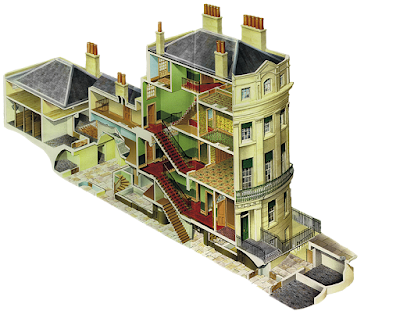Sadly, no pictures are allowed inside. but you can do virtual tours on the website if you click here.
This blog has carried several posts on the Pavilion before the Duke of Wellington Tour.
Click here for Tripping the Light Fantastic and interior shots.
Click here for more on the Great Kitchen.
And if you haven’t already visited Brighton, be sure to put it on your next travel itinerary.
THE DUKE OF WELLINGTON TOUR: THE REGENCY TOWN HOUSE
I first visited the Regency Town House about a decade ago, when the restoration project was just getting under way under the guidance of Nick Tyson. The Grade I listed terraced home of the mid-1820s is being developed as a heritage centre and museum to focus on the architecture and social history of Brighton & Hove between the 1780s and 1840s. The Project encompasses so much more than the house itself. In addition to restoring two townhouses, the Project is also delving into the social history of Regency Brighton and Hove. Links on their website will allow you to see who lived in Brighton and Hove at the time and to explore the Bevan and Dewar Letters, which have been transcribed and which give insight into daily and family life in the area from 1824 to 1870. To visit the website of the Regency Town House, click here.
When I knew that the Duke of Wellington Tour would be visiting Brighton as one of it’s stops, I knew that Victoria and I had to include another visit to the Town House for our group to experience this unique project first hand. From the website:
The Regency Town House was built on what had already become the traditional layout for town houses. The domestic offices for the servants were in the basement, the formal rooms were on the ground and first floors and the bedrooms on the floors above. Due to higher land prices in towns, even large houses tended to be built upwards on long, narrow plots. At the back of the house there was a coach house, stable block and quarters for the coachmen and grooms.
If you think that ten years is a rather long time for the restoration to be ongoing, you should keep in mind that the aim is to restore the entire structure, inside and out, to its Regency state. This means work being undertaken by historians and architectural restorers, painters, masons, roofers, carpenters, tilers, etc., etc. all of whom are using traditional building methods and materials. It also means that the costs can sky rocket depending on the phase of work and unfortunately, the Project is often put on hold as new funds are found or raised in order for the work to continue.
Once inside, Nick explained the scope of work that has been ongoing and pointed out, and elaborated upon, many of the architectural details of the period. The background on these was fascinating.
Nick also pointed out the methods that were used to sand down the painted walls so that each individual layer of paint could be analysed and dated.
Many were surprised to learn that Regency paint colours ran the gamut from subdued to bold.
The Town House also curates a collection of period silhouettes, which were on display during our visit alongside a temporary exhibit of historic costumes.
Honestly, we could have stayed for the entire day and never grown tired of listening to Nick explain elements of the Town House and period daily life. He is a font of knowledge, a born storyteller and his passion for the Project is catching. Number One London is seriously thinking about planning a tour centered around the Regency period, the Town House and Brighton as a Royal destination that would include tours and seminars by experts in various fields.
For an online tour of the Regency Townhouse, click here.
You can follow the restoration projects and other events at the Regency Townhouse at their Facebook page, here.
For a 360 degree street view of Brunswick Square, click Google Maps here.
ONE YEAR AGO TODAY…. ON THE DUKE OF WELLINGTON TOUR
Here it is, September 11, 2015…exactly one year after the Duke of Wellington Tour visited Highclere Castle, perhaps better known as Downton Abbey. We were all fans of the show, some more than others, but all thrilled to see the setting for many years of Masterpiece Theater evenings.
The Castle’s website is here.
We rather expected the Earl of Canarvon to welcome us, but apparently he was urgently called away.
(Photo of the library from the website)
OUR PICTURES AGAIN…
Views of the Park
The Gardens
Recently we heard that the Queen is a fan of Downton Abbey, watching for little errors. Click here for the story.
Very soon, Downton will return on TV screens in the UK. On January 3, 2016, Downton Abbey returns to MASTERPIECE on PBS with its 6th and final season set in 1925.
For the Season 6 trailer, click here. Spoiler alert: It bodes ill!
For lots more information from PBS, click here.
THE DUKE OF WELLINGTON TOUR: WHAT KRISTINE SAW FROM THE COACH WINDOW: DOVER TO BRIGHTON
THE DUKE OF WELLINGTON TOUR: WALMER CASTLE
We boarded our ‘bus’ outside the Grosvenor Hotel and met our wonderful driver Graham. As we learned over the next few days, he was a diamond of the first water among coach drivers — remember not to call the vehicle a bus! We set off driving through London into Kent toward the Channel coast.
Wellington’s life at Walmer here.
The Death of Wellington at Walmer here.
Denise an
d I shot almost exactly the same picture as we approached the walls of Dover Castle.

















